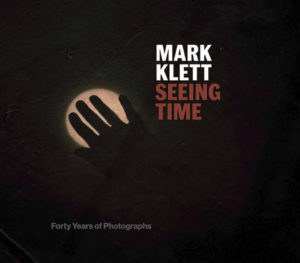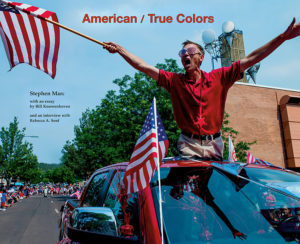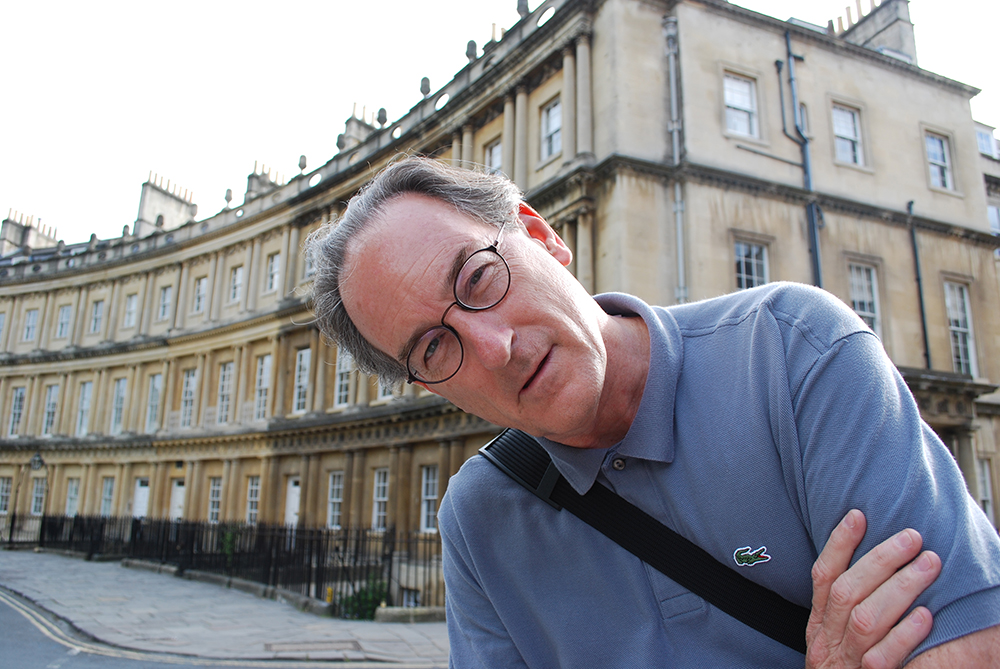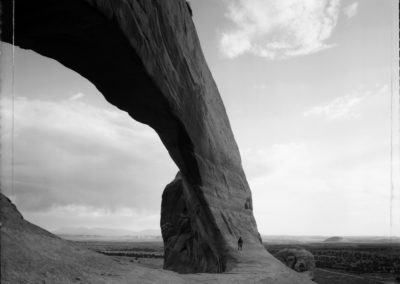Time IS the essence for two superb and significant books published during the past year about two leading Arizona photographers, Mark Klett and Stephen Marc. Mark Klett: Seeing Time, Forty Years of Photographs (University of Texas Press) and American / True Colors (George F. Thompson Publishing) should be on the shelf or table of anyone interested in photographers of our great state. Mark Klett’s entire career, beginning with his early years as a university trained geologist has examined lapses in time from minutes and hours to days and years to geological eons; while Stephen Marc’s work of the last twelve years has focused on moments of time at community events across America such as parades, protests, historic site events, rallies and ceremonies. For over two decades, he has focused his art on social justice, race and everyday struggles in communities.
Friends and colleagues for more than twenty years, Klett and Marc have been professors of art in the Herberger Institute for Design in the Arts at Arizona State University, Tempe. Klett also holds titles of Regents Professor and Distinguished Sustainability Scholar. Marc was recently named a Guggenheim Fellow in Photography by the John Simon Guggenheim Foundation. Both artists have presented exhibitions at Phoenix Art Museum which were accompanied by lavishly illustrated volumes. Marc’s Passage on the Underground Railroad (2012) was comprised of digital documentary montages based on years of research and interviews in 32 states. Also in 2012, Klett collaborated with former A.S.U. student, Byron Wolfe, on Reconstructing the View: The Grand Canyon Photographs of Mark Klett and Byron Wolfe, a project that was the result of several years research and utilization of digital capture technology and computers, Advantaging resources in Arizona, both new books regarding Marc and Klett include written contributions by Rebecca Senf, Ph.D., Chief Curator at the Center for Creative Photography, University of Arizona, who for almost fifteen years has been involved with the exhibition and collection collaboration between the Center and Phoenix Art Museum, a program funded by Doris and John Norton. All are members of the Arizona Photography Alliance.
Though having many career similarities, Marc and Klett’s art could not be more different. Mark Klett has evolved to be one of America’s most respected landscape photographers working in black and white and color mediums. In general, the viewer discovers few people in his images as Klett often chooses to include residue of human life in the landscape such as articles left behind, rock art from early indigenous people, shadows or footprints, all indicating lapses in time. Stephen Marc’s practice has led him to crowd people into his view finder utilizing crisp lines and vibrant colors reflecting myriad community celebrations he documents in his finished images. Having grown up in Chicago and Champaign Urbana, Illinois, Marc has spent his life in more dense urban environments teeming with diverse activities and participants. He is an outgoing, gregarious person with a gift of conversational engagement with just about anyone. His enthusiasm for neighborhood life is exuded in his imagery. Klett, on the other hand, is more introspective and is as comfortable seeking out western American wilderness locations and sharing stories around a campfire as he is in a seminar room with a small group of students.
 Seeing Time is the first book of Klett’s photographs to be retrospective in nature. Thus, the organization of the beautifully designed and printed volume reflects previously published themed subjects represented in focused publications gathered to represent four succeeding periods. Those four periods of the photographer’s interests include his early work, moving to the Southwest, focusing on history and time as a concept, and later projects geographically centered. His in-depth visual examinations over the past two decades of locales such as Yosemite, Grand Canyon, the Colorado River and others are the most compelling. Beyond Klett’s celebrating geologic beauty and time, his melding of location history, environmental challenges, and sustainability, gives us a message that is vital to understanding our immediate future. Successfully capturing a true sense of place, as Klett’s depiction of the landscape has, follows a two hundred year tradition in American art. By embracing new technologies through digital imaging and collaborating with others such as Byron Wolfe, Klett has added his own signature to this convention.
Seeing Time is the first book of Klett’s photographs to be retrospective in nature. Thus, the organization of the beautifully designed and printed volume reflects previously published themed subjects represented in focused publications gathered to represent four succeeding periods. Those four periods of the photographer’s interests include his early work, moving to the Southwest, focusing on history and time as a concept, and later projects geographically centered. His in-depth visual examinations over the past two decades of locales such as Yosemite, Grand Canyon, the Colorado River and others are the most compelling. Beyond Klett’s celebrating geologic beauty and time, his melding of location history, environmental challenges, and sustainability, gives us a message that is vital to understanding our immediate future. Successfully capturing a true sense of place, as Klett’s depiction of the landscape has, follows a two hundred year tradition in American art. By embracing new technologies through digital imaging and collaborating with others such as Byron Wolfe, Klett has added his own signature to this convention.
 Stephen Marc’s imagery in American / True Colors can be seen as fitting into a more recent 20th century standard of documenting street life in the nation. Stylistically, beginning during the New Deal years with Roy Stryker’s coordinated project for the Farm Security Administration (FSA) documenting rural life challenges created the foundation, and artists such as Dorothea Lange, Walker Evans, Robert Frank, Lee Friedlander, Alex Webb, and others have continually moved forward with their in-depth studies of more urban regions. Marc utilizes his ambition to look at American life from California to Maryland and many places in between. However, Arizona garners much attention in the book no doubt due to the artist’s residence here for over 20 years. Looking through the 250 photographs, Marc has truly celebrated the diversity of the Nation’s population by capturing a Chinese New Year’s Celebration in Phoenix, a climate rally in San Francisco, a Civil War reenactment in New York’s Central Park, a Black Lives Matter rally in Selma, Alabama, and the official lowering of the Confederate flag in Columbia, South Carolina. What is remarkable about the photographer’s intention is that he places the viewer in the middle of the action, provides neutral interpretation allowing the event to speak for itself.
Stephen Marc’s imagery in American / True Colors can be seen as fitting into a more recent 20th century standard of documenting street life in the nation. Stylistically, beginning during the New Deal years with Roy Stryker’s coordinated project for the Farm Security Administration (FSA) documenting rural life challenges created the foundation, and artists such as Dorothea Lange, Walker Evans, Robert Frank, Lee Friedlander, Alex Webb, and others have continually moved forward with their in-depth studies of more urban regions. Marc utilizes his ambition to look at American life from California to Maryland and many places in between. However, Arizona garners much attention in the book no doubt due to the artist’s residence here for over 20 years. Looking through the 250 photographs, Marc has truly celebrated the diversity of the Nation’s population by capturing a Chinese New Year’s Celebration in Phoenix, a climate rally in San Francisco, a Civil War reenactment in New York’s Central Park, a Black Lives Matter rally in Selma, Alabama, and the official lowering of the Confederate flag in Columbia, South Carolina. What is remarkable about the photographer’s intention is that he places the viewer in the middle of the action, provides neutral interpretation allowing the event to speak for itself.
Stephen Marc and Mark Klett have, indeed, kept strong the momentum of quality Arizona photography. The state’s dramatic landscape, history, and diverse cultures have attracted major photographers since Alexander Gardner traveled to Arizona territory documenting possible southern trans-continental railroad route in the 1860s. In recent years, Arizona State University has consistently had nationally recognized photographic artists on the faculty. Mark Klett and Stephen Marc have been a crucial part of this remarkable programming.
Main Image Above: © Stephen Marc – (Columbia, SC) from his book American / True Colors

Jim Ballinger
Contributing Writer
Jim Ballinger, Director Emeritus of Phoenix Art Museum has been following the careers of many artists for the past half century. Jim’s interest in photography began when he worked as Registrar with Jim Enyeart, Assistant Director of the Spencer Museum of Art at the University of Kansas. Ballinger’s first controversy with art began at KU as President of Student Friends of Art. With a budget of $200, the Friends decided between a photo realist watercolor of a frozen turkey and a W. Eugene Smith photograph entitled Tomoko Uemura, depicting a deformed young, nude girl suffering from mercury poisoning in a bath. As President, Jim defended the committee’s choice on campus radio by explaining how photography IS actually fine art. The Smith photograph remains in the Spencer collection. Enyeart went on to become the Director of the CCP. Ballinger’s love of Arizona and photography began in 1974 when he arrived in Phoenix as a budding Curator. He explored every part of the state introducing himself to methodology and styles of photography. His early contact with photographers Jay Dusard and Dick Arentz enticed him to begin buying photographs. Jim calls himself an ‘accumulator’ rather than a ‘collector’ and for now his extensive photography library has two new books.
Contact Jim









